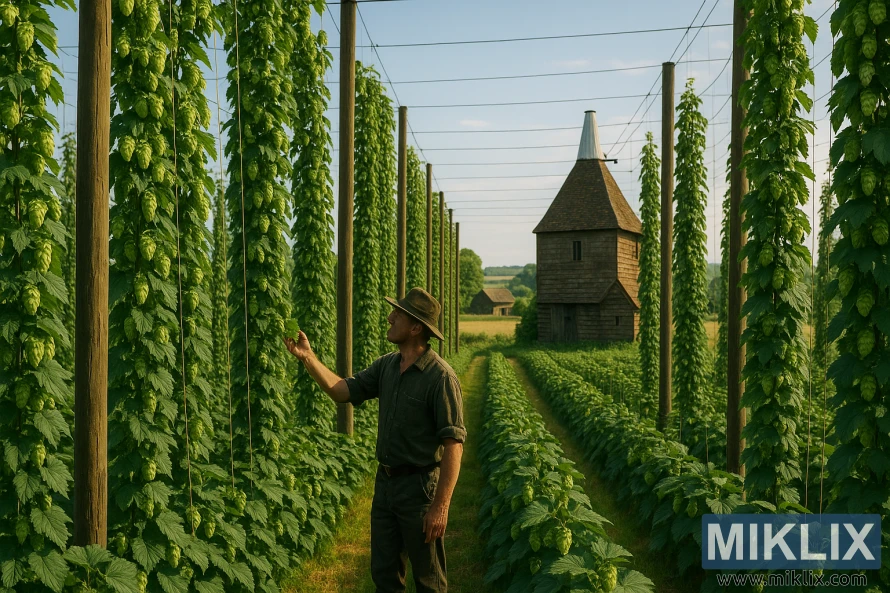Image: Ringwood Hop Field
Published: August 18, 2025 at 7:45:50 AM UTC
Last updated: September 26, 2025 at 9:02:11 PM UTC
A verdant Ringwood hop field with a farmhand inspecting cones, set against rolling hills, a wooden kiln, and a tranquil English countryside backdrop.
The image unfolds in the heart of the English countryside, within the rolling hills of Ringwood, where hop cultivation has been an enduring part of the agricultural and brewing tradition for generations. Towering poles line the hop field in orderly precision, supporting verdant bines that climb skyward with relentless vigor. Each bine is adorned with clusters of aromatic cones, their golden-green hues catching the late afternoon sun as a soft breeze stirs the rows into a gentle, almost rhythmic sway. In the foreground, a farmhand clad in practical workwear and a wide-brimmed hat pauses thoughtfully, his hand reaching up to examine one of the cones with the care and discernment born of experience. His inspection is not casual but deliberate, signaling the delicate balance between timing and craft that defines hop farming—the moment when the lupulin glands are perfectly ripe, when the oils and resins reach their peak, and when harvest will yield the highest quality for brewing.
Just beyond the farmhand, the middle ground introduces an element of deep heritage: an old wooden hop kiln, its darkened timbers weathered by decades of use. With its tall, tapering roof crowned by a vented cowl, the kiln stands as a sentinel of history, a reminder of the essential role such structures played in preserving hops after harvest. Here, generations of growers would have spread the freshly picked cones across slatted floors, allowing warm air to rise from below and gently dry the delicate crop. The kiln’s stoic presence lends gravity to the scene, embodying the continuity of tradition and the quiet passage of knowledge from one generation of hop farmers to the next. It is both a functional building and a symbol of endurance, bridging past and present in the ever-evolving story of English hop culture.
Further back, the background opens into a wide expanse of pastoral beauty. Rolling fields stretch toward the horizon, their boundaries traced by hedgerows and dotted with the occasional weathered barn. The distant tree line rises softly against a clear blue sky flecked with a few scattered clouds, bathing the entire landscape in golden light. This panoramic backdrop enhances the sense of tranquility, grounding the image in the rhythms of rural life where seasons dictate labor and reward. The idyllic quality of the countryside is not romanticized but deeply rooted in the real, lived experience of agricultural work—quietly demanding, yet intimately tied to the land’s cycles of abundance.
The atmosphere of the scene is imbued with timelessness. Every detail—the play of light on the leaves, the tilt of the farmer’s head as he examines his crop, the weather-beaten surfaces of the kiln—contributes to a narrative that transcends the immediate moment. It is a portrait of continuity, of skills refined over centuries, and of a product that holds cultural as well as economic importance. Pride of Ringwood hops, so long associated with both English brewing and their later namesake in Australia, embody this sense of lineage and adaptation. The image becomes more than a snapshot of agriculture; it is a meditation on stewardship, patience, and the bond between human hands and the living plants they tend.
As a whole, the composition conveys rural tranquility with an undercurrent of labor and tradition. It invites the viewer to pause, much like the farmer in the frame, and to consider the journey of hops from field to kiln, from drying floor to brewhouse, and ultimately into the glass. The scene breathes with the quiet confidence of history, where the natural beauty of the English countryside and the artisanal craft of hop farming merge into a single, enduring story.
The image is related to: Hops in Beer Brewing: Pride of Ringwood

